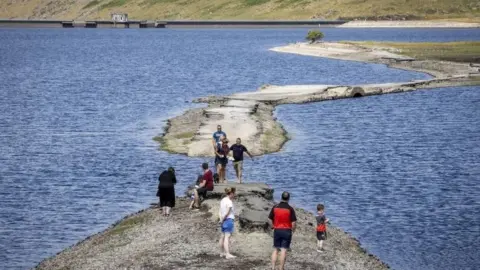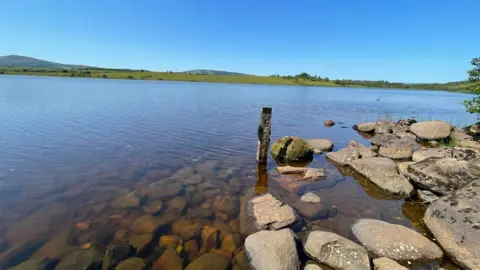Extreme heat: Amber weather warning issued for Northern Ireland
 Pacemaker
PacemakerAn amber warning for heat has been issued for Northern Ireland from Wednesday until the end of Friday.
Northern Ireland could get close to surpassing its hottest day ever - which was set only last weekend.
The Met Office has issued the extreme heat warning, with Met Éireann warnings also in place in the Republic of Ireland.
The Met Office warning comes with an appeal to watch out for heat exhaustion and sunburn.
Temperatures are expected to rise to highs of 29C on Wednesday and into Thursday.
Allow X content?
High overnight temperatures are also expected before a dip on Friday.
On Tuesday night, the first and deputy first ministers issued a joint statement urging people to take care during the period of "extreme heat".
Paul Givan and Michelle O'Neill said the weather should be enjoyed safely.
"Extreme heat can have serious consequences for people's health, public services and the environment. So we ask everyone to take steps to protect themselves," Mr Givan said.
Ms O'Neill said: "Of course many people are keen to experience the good weather, but we ask everyone to take care of themselves, and others so that no one comes to any harm as a result of the extreme heat."
Infrastructure Minister Nichola Mallon urged people to consider if their journeys were necessary before traveling.
Ms Mallon said people should avoid visiting places where there is a chance large numbers of people will gather.
The minister said delays on the road and rail network were likely, which "may result in people being in cars or on public transport for an extended period of time".
Ms Mallon also said the high temperatures have affected the road network, with the bitumen in some roads having softened. She added the situation was being monitored.
Last Saturday, Northern Ireland hit record-breaking heights as thermometers soared above 30C.
It was the hottest day on record with Ballywatticock, near Newtownards in County Down, recording a provisional temperature of 31.2C.

By Cecilia Daly, BBC NI weather presenter
This is the first year the UK Met Office has issued extreme heat warnings.
Some inland areas of Northern Ireland will experience temperatures of 30 degrees or more by day followed by very high temperatures at night.
This very hot weather may affect people's health as well as infrastructure and transportation.
The warning is valid from 08:00 Wednesday until midnight on Friday. The highest temperatures will be inland away from coastal influences and are more likely in parts of Armagh, Fermanagh and Tyrone.
Thing will start to cool down again over the weekend, with temperatures returning to between 20C and 25C.

The Met Office is warning that over the next few days many people could be at risk of sunburn or heat exhaustion, including dehydration, nausea and fatigue.
The more vulnerable are being warned of more adverse health effects.
 Getty Images
Getty ImagesThe Met Office said the high temperatures were expected during the day and at night, meaning disrupted sleep for many.
The warning is in place from 08:00 on Wednesday until 23:59 on Friday.

Ballywatticock verification
By Barra Best, BBC NI weather presenter
Donald Ferguson from the Met Office spent several hours at Northern Ireland's most famous weather station on Tuesday, to verify that the record temperature last week was correct.
"It's just a case of trying to verify the data. Is it good data, was there any external influences that might have skewed the result?" he said from Ballywatticock weather station outside Newtownards.
"It's basically box ticking to make sure there are no red flags that could mean that the potential record isn't actually a record at all."

In a week, we will find out for certain if Ballywatticock is now the holder of Northern Ireland's highest recorded temperature.
Few people, including some locals, had heard of the townland until last Saturday when it recorded 31.2C.
Now people travel for miles to visit the weather station nestled in Donald Crowe's back garden. He has been looking after the weather recordings for 60 years.
"I always enjoyed it over all the years. Rain and sun and everything, it's been a great hobby for me," he said.
"I started in 1956 with a rain gauge and I've been at it ever since."

There have been warnings from NI Water that the system is under extreme pressure due to increased demand in the heat.
Tankers are moving millions of litres to keep reservoirs topped up.
NI Water said people need to reduce their water use or risk running dry.
In the Republic of Ireland, Met Éireann has issued a Status Orange high temperature warning for six areas, with temperatures set to top 30C in some places.
The warning has been issued for Cavan, Monaghan, south Leitrim, Roscommon, Longford, Westmeath and will be in effect from 14:00 on Tuesday until 09:00 on Friday.
 Ciara O'Flanagan
Ciara O'FlanaganThe Met Office launched its new extreme heat warning at the start of June 2021 to highlight potential widespread disruption and adverse health effects. Amber is the second-highest level in the system.
Heatwaves are becoming more likely and more extreme because of human-induced climate change.
The world has already warmed by about 1.2C since the industrial era began, and temperatures will keep rising unless governments around the world take steep cuts to emissions.
